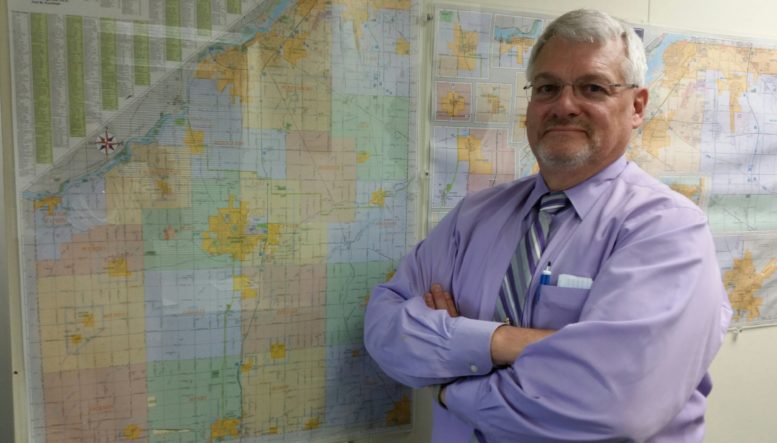By JAN LARSON McLAUGHLIN
BG Independent News
Draining the Great Black Swamp came at great expense. Keeping it drained has also proven to be quite costly.
But the question for many Wood County residents may soon be – exactly how much will it cost them?
Two years ago, the county engineer’s office studied the feasibility of setting up a storm water district in the county to better handle the costs of managing the water that starts here and ultimately ends up in the Maumee River and Lake Erie.
The feasibility study looked at the county’s efforts to keep storm water at bay through ditch maintenance, removing debris in rivers, storm sewer repairs, catch basin repairs and manholes.
Wood County Engineer John Musteric proposed the study, and suggested that the county consider the creation of a storm water district in the unincorporated areas of the county that would charge fees to landowners to support.
The assessments to landowners would be based on the amount of “impervious property” on the parcel. In other words, how much space is covered with rooftops or pavement that doesn’t allow water to soak into the ground.
By setting up a district funded by landowner fees, the county will be able to set money aside for storm water expenses. The district will likely be restricted at first to the northern part of the county, since the storm water issues are greater where more development has occurred.
Many other areas in Ohio already have storm water districts in place, with monthly fees two years ago ranging from $3.47 in Toledo, and $4.06 in Lucas County to $3.50 in Elmore, and $8 in Oak Harbor.
The county commissioners asked that Musteric’s office hold public meetings to inform citizens of the costs to them. But then COVID hit, rendering large in-person public meetings impossible. When the commissioners met with Musteric earlier this week, he said it’s still too early to talk about price tags.
“We don’t have information to give the public at this time,” he said.
In order to get those numbers, Musteric suggested the next phase of a storm water district study be conducted.
“I think we need to at least do this phase so the commissioners know whether to push this thing through or let it go,” he said.
But Musteric cautioned that eventually the Ohio EPA will require storm water districts.
“It’s coming,” he said, since all local ditches drain into the Maumee River or Lake Erie. “It’s inevitable that something has to happen.”
The second phase will result in a roadmap to storm water management, explained Kevin Laughlin, the storm water coordinator in the county engineer’s office.
A study would develop a business plan, establish rates for residential units, and examine how the storm water program can work with the county’s ditch maintenance program – which is already responsible for draining much of the rural acreage in the county.
“This is going to give us a clear picture of what this will look like,” and allow the engineer’s office to answer questions from the public, Laughlin said.
Initially, the storm water district might cover the more developed north end of the county, including the townships of Middleton, Perrysburg, Lake and part of Troy, plus possibly the municipalities of Rossford, Millbury, Perryburg, Northwood and Walbridge.
It is possible the storm water program would later be extended further south into the county.
Musteric assured the county commissioners that his office has no plans to charge both storm water management and ditch maintenance fees on the same acreage.
“What we don’t want to do is double dip,” he said.
And Laughlin explained that unimproved acreage would not be assessed for stormwater.
Large businesses like Amazon and Home Depot have built stormwater retention on their sites, so they will likely be granted credits for that, Laughlin added.
Commissioner Doris Herringshaw asked how the assessment fees would be used. The district would regulate water quality, flooding and drainage.Laughlin said the EPA water quality management mandates are unfunded, and the money could be used for equipment or for infrastructure costs such as building storm sewers or culverts.
Some rural subdivisions in the county have homeowners associations that currently maintain storm water collection. But Musteric said those responsibilities would shift over to the county’s storm water district if it is created.
Herringshaw cautioned that the assessments may be a hard sell for local residents.
“This is really going to take a lot of justification to the public,” she said.

